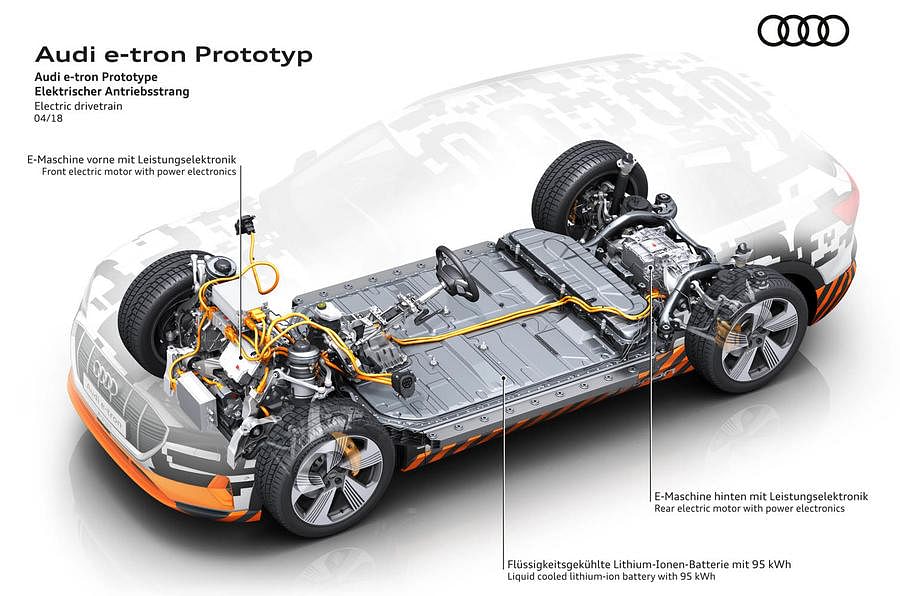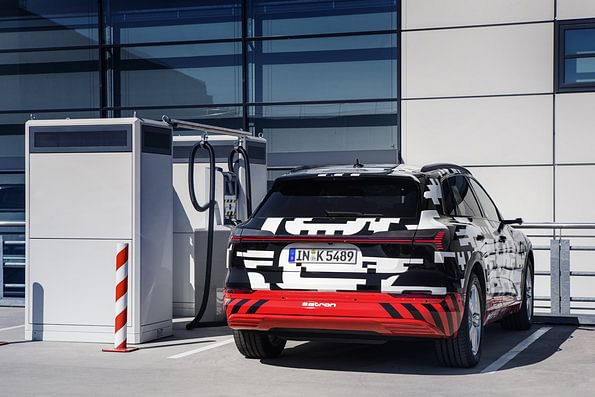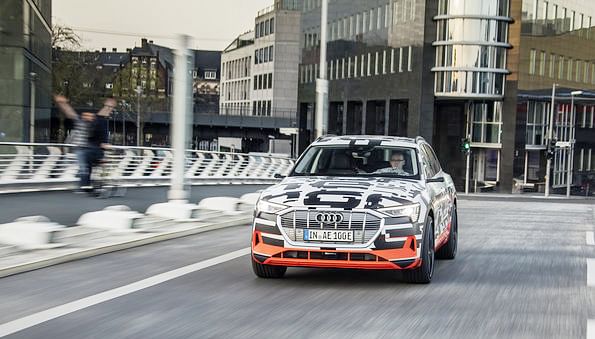Audi E-tron SUV to charge faster than Tesla Supercharger network
Audi has revealed more technical details of its electric E-tron SUV.
Audi has revealed the production version of its E-tron electric SUV will be powered by a two-motor powertrain, 95kWh lithium-ion battery and capable of 150kWh DC fast-charging. The latter is claimed as a world first and is more rapid than the Tesla Supercharger network.
Releasing more technical details ahead of its launch in August, the E-tron was shown to the press at a Siemens heavy-duty electrical engineering test centre in Berlin, where the car was subjected to a symbolic 500kV test to ‘spark’ the car into life.
The exact output of each E-tron motor, however, remains a closely guarded secret, but it's expected to be a maximum of 160bhp with overboost — equivalent to around 120kW — to give a total peak output of around 320bhp or 240kW. 
The production version will be powered by a two-motor powertrain.
That also suggests the E-tron will be badged ‘55’ under Audi’s new naming system that has been introduced to put combustion-engined, hybrid and battery-powered electric vehicles on an even footing in the hierarchy.
“We have decided to keep the E-tron name and use it like quattro,” a source told Autocar UK. “The first of our sporty models was simply named the Audi Quattro. Our first all-electric car will simply be badged Audi E-tron.”
While powerful, the production E-tron’s output is less than the 496bhp quoted for the two concepts shown so far because those featured a three-motor powertrain with a single front motor and twin rear motors.
However, the choice of a twin-motor layout at launch paves the way for Audi to introduce a performance E-tron powered by three motors a couple of years later.

Details of the E-tron’s production lithium-ion battery pack have also been revealed for the first time.
Mounted in the floor, between the front and rear axles, to keep the centre of gravity as low as possible and maximise crash protection, the battery pack will use pouch-type cells packaged into 36 shoebox-sized models.
Each module contains 12 pouches, supplied either by LG Chem or Samsung, and each rated at 60Ah — that's higher than those used by both Nissan and Tesla.
The bulk of the modules are in a flat main casing, but some are housed in a supplementary ‘saddle’ casing above the main battery and under the rear seat.

The battery is not light, though, contributing at least 700kg to the E-tron’s kerb weight.
A key part of the battery is a water-based ‘lattice’ cooling system, bonded to the underside of the modules to maximise heat transfer and shedding heat through a conventional, front-mounted radiator. A second heat pump system with a plate heat exchanger — in effect an air-con system — can boost cooling or heating to keep the battery at its optimum operating range of 25-35deg C in extreme climates.
Charging at home or mainstream-roadside will be via an AC source and is rated at 11kW, although a 22kW charger will be on the options list.
The 150kW DC fast-charger — said to be capable of filling the battery to 80% capacity in 30 minutes — will be standard and takes advantage of the IONITY rapid-charge network being set up by a consortium of Europe’s car makers.
RELATED ARTICLES
Skoda begins sale of made-in-India CKD Kushaq in Vietnam
Before production started, pre-series Kushaq vehicles covered over 330,000 kilometres on a variety of Vietnamese roads a...
Six Japanese companies join forces to expand use of recycled materials in new vehicles
Denso, Toray Industries, Nomura Research Institute, Honda Motor, Matec Inc and Rever Corporation have set up the BlueReb...
BYD selects Voestalpine as steel supplier for its Hungarian plant
The announcement of the Austrian steelmaker as a supplier demonstrates BYD’s strategic plan to source from high-quality,...





 21 Apr 2018
21 Apr 2018
 9161 Views
9161 Views
















 Autocar Professional Bureau
Autocar Professional Bureau




